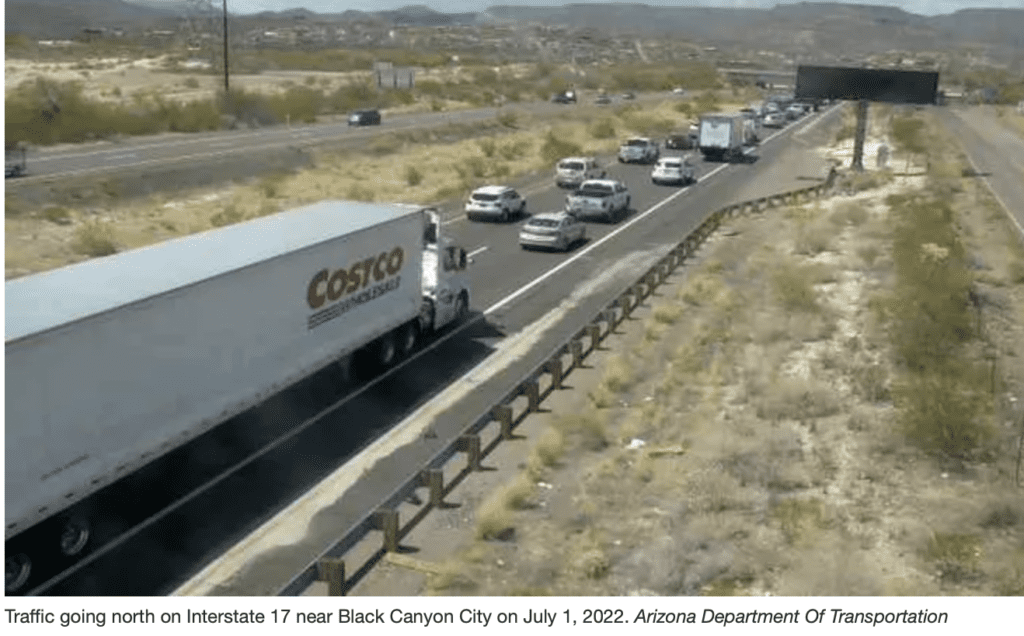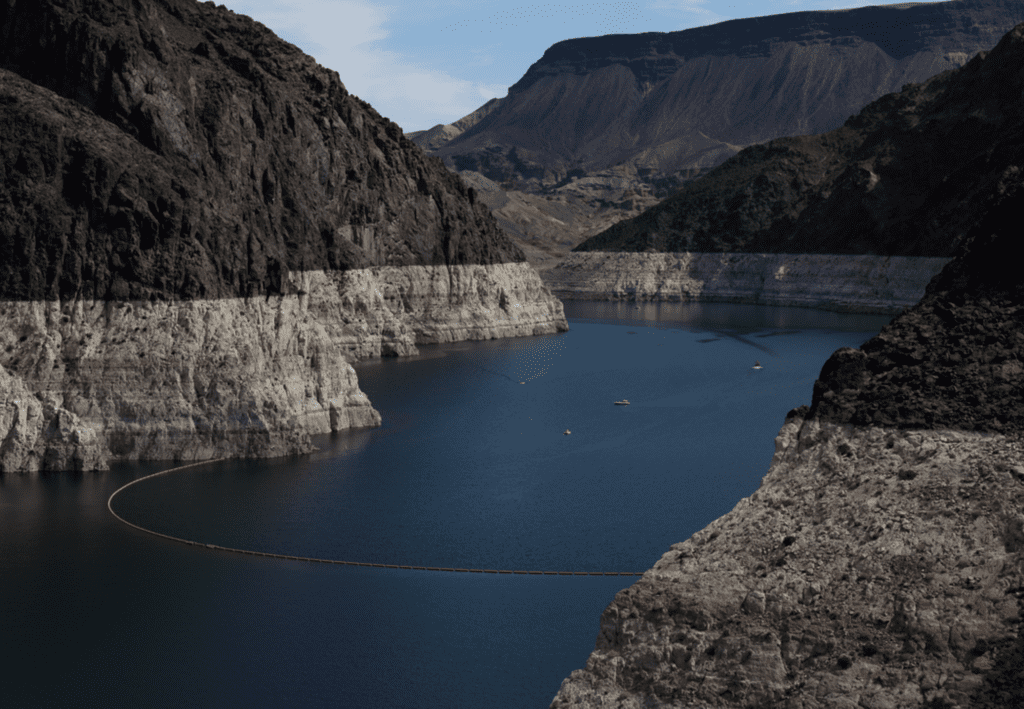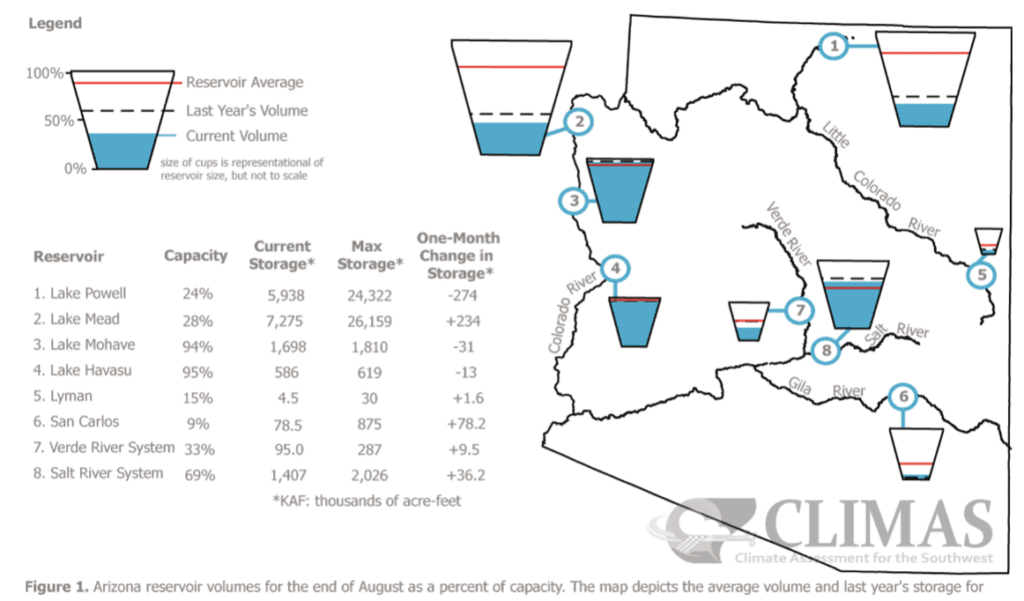Daniel Salzler No. 1169 EnviroInsight.org Six Items September 30, 2022
—————Feel Free To Pass This Along To Others——————
If your watershed is doing something you would like others to know about, or you know
of something others can benefit from, let me know and I will place it in this Information newsletter.
If you want to be removed from the distribution list, please let me know.
Please note that all meetings listed are open. Enhance your viewing by downloading the pdf file to view photos, etc. The
attached is all about improving life in the watershed. If you want to be removed from
the distribution list, please let me know. Please note that all meetings listed are open.
Check our website at EnviroInsight.org
1. Widening Interstate 17 Could Spell Trouble For Black Canyon City’s Water Supply
Opinion: ADOT plans to use nearby groundwater to widen Interstate 17 near Black Canyon City. It’s a worthy project, but one that could have catastrophic consequences for residents.
Mary Hoadley and Tim Flood opinion contributors to Arizona Republic

A compelling case study of conflicting water interests is unfolding in Black Canyon City, where the Arizona Department of Transportation (ADOT) is preparing much needed improvements to 22 miles of Interstate 17.
It poses serious implications for Arizona’s efforts to better manage its ever-dwindling groundwater.
In an area that’s outside of a regulated Active Management Area and dependent on a shallow aquifer, the two main water providers – Black Canyon City Water Improvement District and Cold Water Canyon Water Company – have determined they cannot risk their water supply by providing construction water to ADOT.
Private well owners are free to sell their water and several have contracted with Kiewitt-Fann Joint Ventures, ADOT’s contractor, to do just that. But well levels have already dropped 2 feet this summer. The monsoon has not helped the Agua Fria, a major source of groundwater recharge, to flow consistently, and users are facing a serious Stage 3 set of water restrictions.
Construction has yet to start. [BUT IS STARTING SOON]
Previous road construction dried up a spring|
When ADOT reconfigured the Cordes Junction Traffic Interchange from 2010 to 2013, water usage caused a nearby spring to dry up. The contractor was free to obtain water from a local water company that was free to provide it. But Big Bug Spring on the Miramonte Ranch in Spring Valley dried up for five years, impacting both livestock and wildlife.
As a result, the Upper Agua Fria Watershed Partnership met several times with ADOT arguing that only sustainable water resources should be used for ADOT construction. That is, no existing user or the environment should be adversely impacted. In fact, we asked that ADOT mandate that any future contractor use only sustainable sources.
No solution:Lawmakers have done little to address rural groundwater problems
Kiewitt-Fann Joint Ventures is planning to use 65 to 114 million gallons of water, some reclaimed from Anthem, some from their wells at Table Mesa Road. But it also is lining up Black Canyon City water from private wells.
The residential concern is that as groundwater is withdrawn for the project, if the aquifer is affected and water levels drop, there is no commitment from ADOT to monitor or to stop the local water overdraft. |
The Upper Agua Fria Watershed Partnership covers 1,200 square miles from Dewey Humboldt to Lake Pleasant and Crown King to Pine Mountain. It consists of federal, state, county and local agencies, private property holders and the general public with a focus on water quantity and quality as well as watershed health. The group has been considering this issue for the past year at its monthly meetings urging ADOT to source water responsibly.
How ADOT could minimize impacts to wells
Should 2,500 people suffer for a worthy project?
ADOT gets credit for transparency regarding the Anthem to Sunset Point Improvement Project. The thorough public meeting in Black Canyon City in May answered many questions except those regarding source water for construction. ImprovingI17.com is packed with information and welcomes questions.
What could ADOT do to assure a sustainable sourcing of construction water necessary for dust control, soil compaction, gravel washing and concrete production?
- Conduct water supply studies in known vulnerable areas being considered for use.
- Require well monitoring in vulnerable areas used by the ADOT contractor and commit to cease withdrawals if adverse impacts to existing users are detected.
- Use the ADOT well at Sunset Point, which was completed some years ago. It included in its final report the concept of lowering that well up to 1,000 feet to provide construction water in the future.
- Require ADOT’s contractor to use more reclaimed water from Anthem.
- Use other commercial water providers, such as 310 Dust Control, which has just installed a temporary 1.8 million-gallon tank in Black Canyon City, filling it with tanker trucks from Pioneer Road, for Kinder Morgan’s gas line maintenance.
- Explore ways to reduce water demand for dust control and construction, by using polymers or chlorides, or via more efficient design and scheduling tactics.|
Yavapai County Supervisor James Gregory asked a representative from the Arizona Department of Water Resources if the department could or would intervene in the event of a Black Canyon City water crises triggered by ADOT construction. The answer was no, ADWR has no authority in areas not designated as Active Management Area.
We need more tools to manage rural groundwater
The Black Canyon City project highlights the need for a statute to better manage groundwater in rural (non-AMA) areas.
The state House and Senate natural resource committees have stymied all attempts for decades to address the problem. The committee chairs don’t even hold hearings to discuss the issues.
State Rep. Regina Cobb of Kingman promoted the concept of RMAs – Rural Management Areas – to allow for rural water management in areas determined by the county, to no successful conclusion.
Increasing aridification, more demands on our shrinking water resource, private wells and public springs drying up with no remedy all require creative, cooperative, future-considerate solutions.
It is time for the Legislature to act.
Mary Hoadley is chair of the Upper Agua Fria Watershed Partnership. Tim Flood is the water team lead for Friends of the Agua Fria Monument. Reach them at [email protected] and [email protected].
2. Wildfires And Snowpack. According to new research, wildfires are increasingly altering the snowpack in the Western United States. Researchers found that from 1984 to 2020, 70 percent of late-melt snow zones saw a significant increase in wildfire activity. High Country News reports that the study also found that snow in burned areas contains less water — a discovery that may impact how water is managed in the future. In areas already experiencing drought due to climate change, fire can further exacerbate water shortages. Source: Brown and Caldwell.

3. Western Reservoirs Could Run Dry In 3 Years, Top Official Warns. A top Centennial State official warned Colorado River Basin states that the system’s federal reservoirs could effectively empty in a few short years barring aggressive reductions to water demands.
Colorado River Water Conservation District General Manager Andy Mueller painted a bleak future for the basin’s seven states — Arizona, California, Colorado, Nevada, New Mexico, Utah and Wyoming — on Friday, during his organization’s annual conference in Grand Junction, Colo., on the river’s future.
“If we continue in the way we’re operating now, if we don’t reduce our demands, we’re going to really see those reservoirs really hit a crisis,” Mueller said. “I’m not talking about in 20 years, I’m talking about in the next three or four years. We have a period of time here to change our use.” Source: Green Wire E&E News.
4. Top Five Items That Should Be On Your Fall Home Maintenance Checklist. American Home Shield suggests you check these five things to prepare for old weather, if they apply.|
1. Get Your Heating System Humming
You don’t want to wake up on the coldest morning to find you have no heat. Check out your. An expert technician will make sure everything is running properly and that your system meets the manufacturer’s rated efficiency. The checkup will also measure carbon monoxide leakage.
2. Prevent Gutter Gridlock
Leaves, twigs and other debris can clog gutters, which can lead to ice dams. Ice dams cause melting water to back up and flow into your house. Save yourself from this expensive repair by cleaning the gutters after your leaves have fallen. Tighten gutter hangers and downspout brackets, and replace any worn sections. Check that your downspouts extend at least five feet away from the foundation. If not, you can buy inexpensive extensions and attach them.
3. Take a Caulk Walk
Walk around the exterior of your home and check it for air tightness. Carefully look for cracks, which can be the source of air leaks, energy loss and money down the drain. An inexpensive tube of caulk can help prevent energy loss and also help prevent moisture from getting inside the walls of your home. Caulk and seal air leaks where plumbing, ducting or electrical wiring comes through walls or floors.
5. Upper Agua Fria Watershed Partnership October 4, 2022, 10 am
Please join my meeting from your computer, tablet or smartphone. https://global.gotomeeting.com/join/555529925
You can also dial in using your phone. United States: +1 (312) 757-3121
Access Code: 555-529-925
New to GoToMeeting? Get the app now and be ready when your first meeting starts: https://global.gotomeeting.com/install/555529925
Draft Agenda
1. Introductions and Announcements
2. Arizona Metals Black Canyon City Kay Mine – Update
3: Solar Farm Proposals: UAFWP role now? Any updates. ASLD Board of Appeals Meetings
4. ADOT <improvingi17.com>. Water Sources for Construction; updates; Supervisor Gregory Black Canyon City October 10 Meeting:Review ADOT Water Message Points; Review Greg Watts questions for ADOT and KFJV; encourage wide audience
5. Organizational efforts for UAFWP; State of the Verde Conference connections and insights
6. Black Canyon Heritage Park: AF presentation for November 1, www.azwaterfuture.org – Ann Hutchinson; Black Canyon Trail
7. FAFNM: Annual Meeting September 24 report; aguafriafriends.org
8. Other Business
Save the Date: November 1, 2022 Meeting – in person at Chauncey Ranch; tour and bring your lunch
6. Climas – September 2022
Monthly/Seasonal Precipitation and Temperature: Aug precipitation was above average or much above average in most of Arizona. August temperatures were between below average and much above average in Arizona. Water year precipitation has rebounded considerably with the monsoon, and now ranges between below average and above average in most of Arizona.
Summer precipitation rankings for the region demonstrate why, with widespread areas of either record wettest or much above average.
Drought: The Sept 6 U.S. Drought Monitor (USDM) shows another month of widespread decreases in the severity of drought characterizations in Arizona following widespread monsoon activity (See Fig. 3). Despite the regional improvement, drought conditions are still found across most of the southwestern United States. Accumulated precipitation deficits are a factor in these designations. Sustained monsoon activity continues to help reduce extreme drought characterizations but is not enough to fully reverse long-term drought conditions.

Precipitation Forecasts: The IRI outlook for Oct-Nov calls for increased chances of below average precipitation in most of Arizona. The NOAA-CPC outlook for Oct-Dec calls for increased chances of below average precipitation Arizona. The October outlook calls for increased chances of below average precipitation in the upper Colorado River.
Temperature Forecasts: The IRI outlook for Oct-Nov calls for increased chances of above average temperatures across the Southwest.. The NOAA-CPC outlook for Oct-Dec calls for increased chances of above average temperatures across the Southwest.
|
Copyright: EnviroInsight.org 2022
